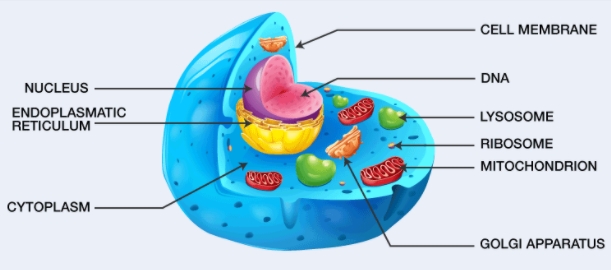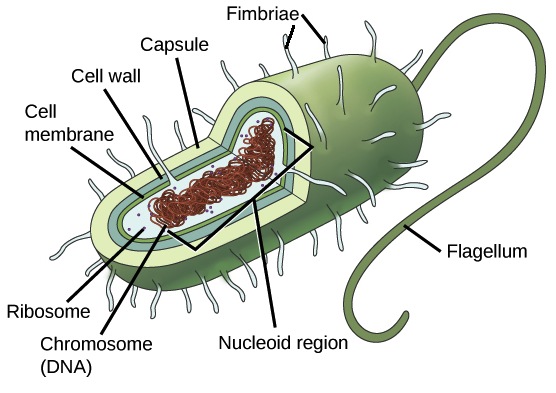Definition Of Cell
The smallest unit of all living things is the cell. Hence, the cell is the smallest identity component of any living thing that can be split to the cellular level.
Find out more about cells by reading up on their definitions, structures, and roles. All the cellular ideas are explained in detail in these notes.

What is a Cell?
The cellular level is the most basic and fundamental level of life. Cell Biology refers to the study of cells and its constituent organelles, from their atomic structure to their specific roles within the cell. The first biologist to discover cells was Robert Hooke.
Each living thing consists of individual cells. Single-celled (unicellular) or multicellular structures are also possible for them (multicellular). The tiniest living organisms are mycoplasmas. All living things are composed of cells. They help keep you together and turn the food you eat into energy.
Types of Cells
As in a factory, various workers and departments in a cell all contribute to the final product. The many diverse cell types each have a specific purpose. There are two specific types of cells, separated by their internal structure:
- Prokaryotes
- Eukaryote
Explore: The difference between prokaryotic and eukaryotic cells
Prokaryotic cell

- There is no nucleus in prokaryotic cells. Specific prokaryotes, like bacteria, have a space inside the cell where the DNA is hanging freely. The term “nucleoid” describes this structure.
- These are all unicellular creatures. Archaea, bacteria, and cyanobacteria are all examples of microorganisms.
- Between 0.1 and 0.5 m is the size of a typical cell.
- DNA or RNA may be used as the genetic material.
- Binary fission is an example of asexual reproduction common to prokaryotes. Conjugation, considered by many to be the bacterial analogue to sexual reproduction, is another reproductive strategy at their disposal (however, it is NOT sexual reproduction).
Eukaryotic cell

- A genuine nucleus is an unique characteristic of eukaryotic cells.
- Cell diameters are typically between 10 and 100 m.
- Plants, fungi, protozoa, and mammals are all included under this umbrella term.
- The plasma membrane controls the flow of substances into and out of cells, including nutrients and electrolytes. It’s also what allows cells to talk to one another.
- They are capable of both sexual and asexual reproduction.
- Cells of plants and animals differ in a few key ways. Plant cells, in contrast to animal cells, have plastids such chloroplasts, central vacuoles, and others.
Cell Structure
The structure of a cell consists of specialized parts that work together to maintain life. The cellular components are the organelles, cytoplasm, nucleus, and cell membrane. Keep reading to get more information about how cells work and how they are built.
Cell Membrane
- The cell’s membrane is there to keep it together and safe. It regulates the transport of chemicals into and out of cells. This creates a barrier between the inside of the device and the outside. All cells have a membrane around their inside.
- All of the cell’s internal organs (including the cytoplasm and nucleus) are linked to the cell membrane, which serves as the exterior coating of the cell. The plasma membrane is another name for this.
- The membrane’s pore-filled structure allows for the selective passage of certain substances into and out of the cell. Moreover, cell membranes prevent leakage and harm to cellular components.
- This forms a barrier between the two units and the environment outside the unit.
- The sturdy nature of plants makes their cells ideal for shielding them from the elements. The cell wall plays an important role in enhancing this process.
Cell Wall
- The cell wall is the most remarkable feature of plant cells. You’ll find cellulose, hemicellulose, and pectin in its structure.
- Only plant cells have a cell wall. It shields the cell’s membrane and other parts from damage. The cell wall is the cellular envelope that surrounds plant cells.
- It is a stiff framework that surrounds the membrane of the cell.
- It accommodates the battery’s dimensions, gives it structural support, and shields it from mechanical stress.
Cytoplasm
- The cytoplasm is a solid, see-through, nutrient-rich material found inside the cell membrane.
- The cytoplasm is the primary site of cellular chemical activity.
- The cytoplasm contains organelles such the endoplasmic reticulum, Vocal, mitochondria, and ribosomes.
Nuclear
- DNA, the cell’s biological material, is stored in the nucleus.
- It regulates cellular processes like proliferation, differentiation, and death.
- A nuclear membrane surrounds the nucleus and keeps DNA isolated from the rest of the cell.
The nucleus protects DNA and is an integral part of the cell structure of the plant.
Functions of Cell
These primary tasks are carried out by cells and are essential for an organism’s survival and development. The unit’s primary roles are as follows:
Provides Support and Structure
In a sense, every living thing consists of cells. These are the fundamental building blocks of all organisms. Cell membranes and cell walls serve as the primary structural components of all living organisms. The skin, for instance, has millions upon trillions of individual cells. Plants’ xylem cells make up the vascular system and help hold the plant together.
Promote Growth Mitosis
Mitosis is the process through which a parent cell gives rise to its offspring. Thus, cell division is essential for organism development.
Permitted substance
In order to provide energy for their internal chemical activities, cells take in food from the outside environment. Active and passive transport remove the byproducts of the chemical reaction from the cell. Oxygen, carbon dioxide, and ethanol are examples of small molecules that may diffuse through a cell membrane in response to a concentration gradient. The process through which information is passed on in this way is known as passive transmission. Active transport across the cell membrane is necessary for the diffusion of larger molecules, which results in a significant increase in the amount of energy needed to get the material into the cell.
Energy Production
Energy is essential for cells to carry out their many chemical reactions. Photosynthesis and animal respiration both contribute to the cellular production of this energy.
Aids in Reproduction
Cells aid in the reproductive process by undergoing mitosis and meiosis. Asexual reproduction, which occurs during mitosis, involves the division of parent cells to produce daughter cells. Meiosis is responsible for the genetic differentiation of mayonnaise cells. So now we know why cells are considered the building blocks and the engines of life. This is because they play an essential role in facilitating the functioning of living beings by providing the framework upon which life depends.
See Also:
- What is genetic testing: Describe Its Types
- Genetically Modified Organism: Define Its Examples, & Facts
- Organism: Describe Its Types and Examples